
In today’s automotive landscape, safety remains a top priority for both manufacturers and consumers. If you own a Ford vehicle, it’s vital to stay informed about any recalls or safety alerts that may impact your car’s performance and your safety on the road. Regularly checking for updates ensures that you can take prompt action if needed.
Recalls are issued when a product does not meet safety standards or poses potential risks to drivers and passengers. As a Ford owner, you have the responsibility to check for any recent recalls affecting your vehicle model. This proactive approach not only safeguards your well-being but also enhances the longevity and reliability of your vehicle.
In this article, we’ll explore the steps you can take to stay updated on the latest recalls and safety alerts for your Ford. Understanding the importance of these notifications will empower you to maintain your vehicle in optimal condition while ensuring the safety of everyone on the road.
How to Perform a VIN Check for Recalls on Your Ford
To ensure the safety and reliability of your Ford vehicle, it’s crucial to perform a VIN check for any active recalls. The Vehicle Identification Number (VIN) is a unique code assigned to every vehicle, which can provide detailed information about its history, including any safety recalls issued.
Start by locating your Ford’s VIN, typically found on the driver’s side dashboard or inside the driver’s side door frame. Once you have the VIN, you can proceed with the check.
Visit the official Ford website or the National Highway Traffic Safety Administration (NHTSA) website. Both platforms offer tools for checking recalls. Simply enter your VIN into the designated field and submit your query. This will allow you to access any currently outstanding recalls associated with your vehicle.
If your Ford has any recalls, the website will provide detailed information regarding the nature of the recall and the necessary steps to address it. This may include information on authorized service centers where you can get the issues resolved at no cost.
Additionally, consider checking with your local Ford dealership. They can also perform a recall check using your VIN and assist in scheduling any required service. Regularly performing this check is an essential part of vehicle maintenance, ensuring that your Ford remains safe on the road.
Understanding the Importance of Safety Alerts and Recalls

Safety alerts and recalls are critical components of vehicle ownership. They serve as vital notifications to owners, ensuring that their vehicles are safe and compliant with current safety standards. Understanding these alerts can help you safeguard your well-being and that of your passengers.
When a manufacturer identifies a potential safety issue, a recall is issued. This can include defects that affect the vehicle’s performance, safety features, or overall compliance. The following are key reasons why monitoring safety alerts and recalls is essential:
- Protection of Lives: Recalls often address issues that could pose direct risks to drivers and passengers. Being informed can prevent accidents and injuries.
- VIN Tracking: Each vehicle has a unique VIN (Vehicle Identification Number) that helps in tracking recalls. By providing your VIN to manufacturers or checking on their websites, you can quickly determine if your vehicle is affected.
- Financial Responsibility: Participating in recalls can save you from costly repairs down the line. Manufacturers typically cover the cost of repairs for recalled vehicles.
- Enhanced Vehicle Performance: Some recalls involve improvements that enhance your vehicle’s performance. Addressing these issues can result in better handling, braking, and overall functionality.
- Informed Decision-Making: Regularly checking for safety alerts enables you to make informed decisions about your vehicle’s maintenance and upgrades.
In conclusion, staying updated on safety alerts and recalls is more than just a routine check; it is an essential practice for responsible vehicle ownership. Always ensure to use your VIN to verify any recall statuses for your Ford vehicle and take the necessary actions promptly.
Steps to Take if Your Ford is Affected by a Recall

If you find out that your Ford vehicle is affected by a recall, it’s essential to take immediate action to ensure your safety and the safety of others on the road. Follow these steps to address the recall situation effectively.
1. Check the Recall Details: Begin by visiting the official Ford website or the National Highway Traffic Safety Administration (NHTSA) site to verify the details of the recall. You will need your vehicle identification number (VIN) to get accurate information about the specific recall affecting your vehicle.
2. Contact Your Local Dealer: Once you confirm the recall, contact your local Ford dealership. Provide them with your VIN and discuss the recall specifics. The dealer can inform you about any necessary repairs and the availability of parts.
3. Schedule an Appointment: After discussing the recall with the dealer, arrange for an appointment to have the necessary repairs performed. Many recalls can be addressed free of charge, so confirm any costs beforehand.
4. Keep Records: Document all correspondence and service appointments related to the recall. This information may be valuable for future reference, especially if you encounter any issues related to the recall repairs.
5. Stay Informed: Continuously check for updates about the recall status and any additional alerts that may be issued. Stay connected with Ford and your dealer for any ongoing maintenance needed for your vehicle.
6. Report Any Problems: If you experience any issues after your vehicle has been repaired, report them immediately to your dealer and the NHTSA. Your feedback can help improve safety for all Ford drivers.
By following these steps, you can stay proactive about your Ford’s safety and ensure that you take appropriate action if your vehicle is affected by a recall.



